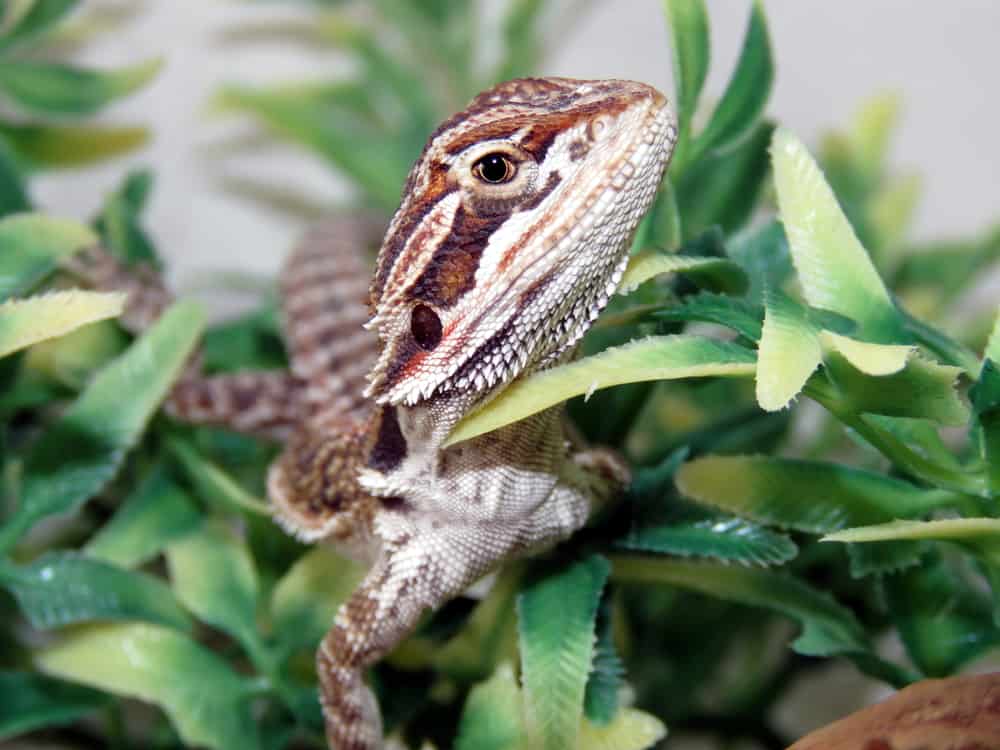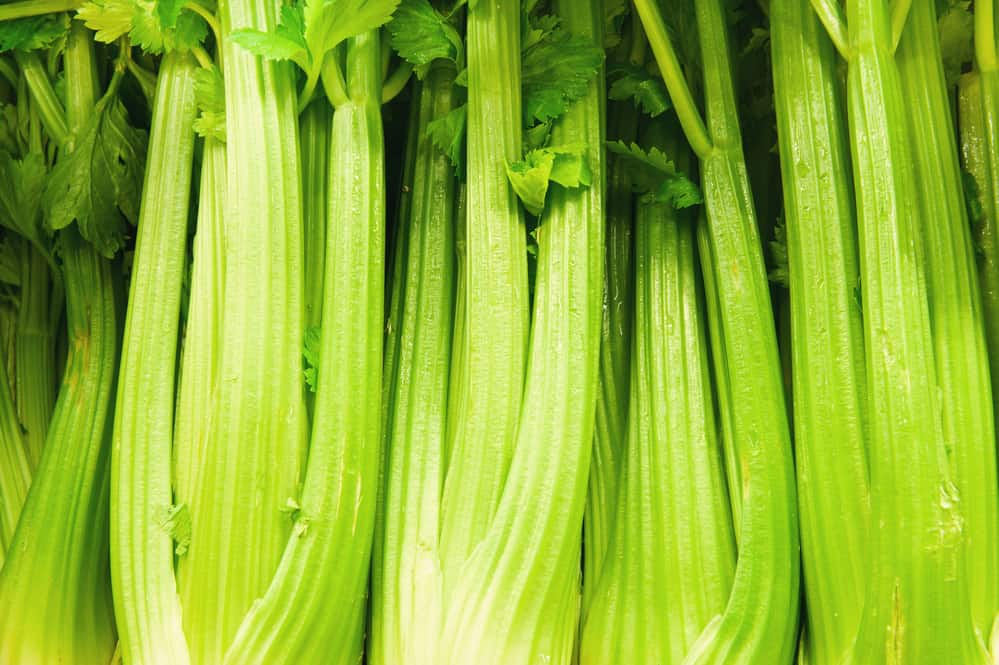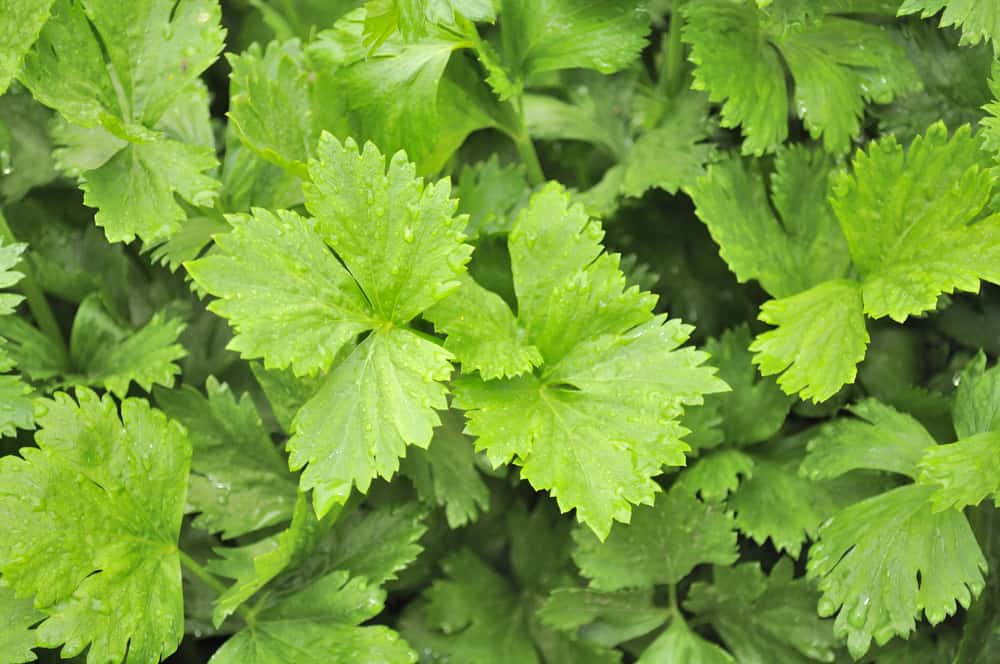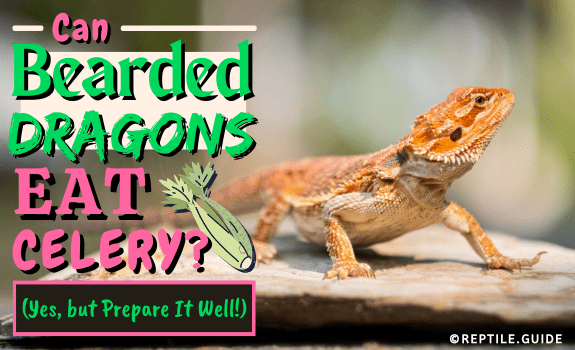Yes, bearded dragons can eat celery, but it doesn’t offer many nutrients that bearded dragons need.
However, this vegetable offers a few worthwhile nutrients and minerals. It’s not harmful to your bearded dragon.
You can give your bearded dragon a couple of pieces of celery once a week.

In This Article
Nutritional Value of Celery
Celery is an interesting vegetable that contains many useful nutrients and minerals.
According to the FDA, a single 100-gram portion of celery contains the following nutritional elements:
- Iron: 0.2 milligrams
- Fiber: 1.6 grams
- Sugars: 1.34 grams
- Protein: 0.69 grams
- Calcium: 40 milligrams
- Vitamin A: 22 micrograms
- Vitamin E: 0.27 milligrams
- Vitamin K: 29.3 micrograms
- Potassium: 260 milligrams
- Vitamin B-6: 0.074 milligrams
- Magnesium: 11 milligrams
- Phosphorus: 24 milligrams
- Beta-Carotene: 270 micrograms
Many of these elements, like Calcium, protein, and fiber are essential parts of a bearded dragon diet.
Fun Fact: Unlike most common vegetables, celery has the appropriate ratio of calcium to phosphorus for your bearded dragon.
Can Baby Bearded Dragons Eat Celery?
Yes, baby bearded dragons can eat celery.

If you give your baby bearded dragon celery, ensure that you give it in small amounts.
Bearded dragon juveniles are much less resistant to the effects of calcium-binding substances like oxalates.
It’s also more important for your young beardie to get meals with a high nutritional value.
We don’t recommend feeding a baby bearded dragon celery more than once a month.
Can Bearded Dragons Eat Celery Leaves?
Yes, a bearded dragon can eat celery leaves.
Not only can bearded dragons eat celery leaves, but they’ll probably enjoy them too.
Beware of feeding your beardie too much celery, and ensure that you chop the celery you give them into small manageable pieces.
Can Bearded Dragons Eat Celery Sticks?
Bearded dragons can eat celery sticks, and many of them enjoy this crunchy snack.

When feeding celery stalks to your beardie, ensure that you chop them small. Celery stalks often contain long fibers that can become a choking risk.
As with all other parts of the celery plant, feeding in moderation is the key.
How Often Can Bearded Dragons Eat Celery?
You can safely feed celery to your bearded dragons roughly once a week.
While this vegetable isn’t loaded with nutritional value, it isn’t unhealthy and contains a few useful nutrients.
You don’t want to feed this food to your beardie more often. It may fill the lizard but won’t give the dietary value you want to promote.
How to Feed Celery to Your Bearded Dragon
If you want your bearded dragons to get the most from their celery, then you need to prepare it the right way.
Here’s a step-by-step guide about how to prepare celery for your bearded dragons:
- Wash the celery stalk and leaves thoroughly to ensure there aren’t any chemical residues on the plants.
Pro Tip: It’s always best to buy organic produce that you know is pesticide-free. You can also grow a pesticide-free garden to help offset feeding costs.
- Check the leaves and celery stalk for any rust, rotten pieces, or other blemishes. Remove the affected segments with a small, sharp knife.
- Cut the celery into small pieces of around 1/4 inch. Remember that this vegetable is tough and fibrous, and the smaller pieces will help the bearded dragon to eat it.
- While you can boil the celery in plain water, we don’t recommend cooking it. Cooking may destroy some of the few valuable nutrients the celery contains.
- Add the chopped celery to the bearded dragon’s food bowl (remove it from the enclosure first).
- Chop some other valuable fruits and vegetables, adding them to the bowl as well.
- Sprinkle the bowl of food with calcium powder, and any multivitamin powders you’re using.
- Mix the food and powders thoroughly.
- Give the food to your bearded dragon.
Pro Tip: When you prepare celery, it’s vital to cut the celery leaves into small pieces, because they can be tough and can be a choking hazard.
Pros of Feeding Celery to Your Bearded Dragon
Not only can bearded dragons eat celery, but this vegetable offers some dietary benefits. We’ll look at some of them in the following sections.
Calcium to Phosphorus Ratio
Bearded dragons require a specific ratio of calcium to phosphorus to stay healthy. Like spinach, celery contains almost that exact ratio.
When present in large amounts, phosphorus binds to calcium and prevents your bearded dragon’s body from absorbing it.
Bearded dragons, especially young animals, need large amounts of calcium to build their bones and keep their bodies healthy.
For both these reasons, your bearded dragon requires a 2:1 ratio of calcium to phosphorus.
Celery leaves contain around 40 milligrams of Calcium and about 24 milligrams of phosphorus. In other words, nearly a 2:1 ratio.
This is a rare find among vegetables, so you want to give your bearded dragon celery now and again.
Celery Has a High Water Content
Bearded dragon owners generally try to feed their pets a diet with high nutrition.
While water-rich diets aren’t always desirable, they can be helpful when your bearded dragon has been sick or is dehydrated.
A celery stalk consists of around 95% water. While this isn’t ideal in most cases, it can help hydrate an animal that doesn’t want to drink.
Celery Has a Good Fiber Content
Fiber is an essential part of most creatures’ digestive process.
Bearded dragons, like most herbivores and omnivores, require more fiber than a purely carnivorous species.
This is because the tough foliage that these animals eat in the wild naturally contains high amounts of fiber. As a result, these animals require a higher fiber percentage in captivity.
Celery contains around 1.6% of fiber. While this isn’t high, it’s about 1/5 of the celery’s non-water content.
Celery Has Low Sugar Content
While bearded dragons naturally eat a lot of roughage, they don’t eat a lot of fruit in the wild.
Since these animals are essentially folivores (eating mainly leaves) in the wild, they’ve never had to adapt to deal with sugars.
Many of the fruits and vegetables we eat have been developed over time. They’re sweeter than their ancestors and have higher sugar content.
Celery is a healthy addition to a balanced diet since it contains little sugar. Around 1.6% of a 100-gram portion of celery consists of sugars.
Cons of Feeding Celery to Your Bearded Dragon
As with any vegetable or food source, there are disadvantages to feeding your bearded dragon celery. The following segments will give you the main disadvantages.
Celery Is Low in Nutrients
Celery contains some useful nutrients, but not many and not a lot of them. Some of the important vitamins celery leaves offer include:
- Vitamin A
- Vitamin K
- Vitamin B-6
- Vitamin B-12
Other valuable nutrients include:
- Iron
- Fiber
- Calcium
- Potassium
- Magnesium
- Phosphorus
However, for the most part, celery leaves don’t offer your bearded dragon much nutrition.
Only 5% of this plant’s value consists of nutritional elements. The other 95% consists of water.
Since bearded dragons eat only once a day, and have fairly high nutritional requirements, you want to avoid overfeeding foods like celery that don’t provide much dietary value.
Celery Contains a LOT of Water
While a high water content is advantageous for dehydrated or sick animals, you DON’T want to feed that much water in your general bearded dragon diet.
You only feed your bearded dragon once a day. When you give it that meal, you want it to consume as many nutrients and minerals as possible.
Celery has an almost 95% water content, meaning it only has around 5% nutritional value. Of that 5%, fiber and sugars make up more than half.
Feeding too much celery and other water-rich foods with little nutritional value can lead to various problems. These include:
- Diarrhea
- Malnutrition
- Metabolic bone disease
The other aspect to this con is that pet bearded dragons don’t need to take in water through their food.
Captive lizards have (or should have) constant access to a water bowl. Because of this, your bearded dragon can drink all the water it needs to sustain itself.
Since bearded dragons are a desert species, they have fairly low water requirements.
Celery Contains Many Oxalates
Another problem with celery is that it contains many oxalates.
Oxalates, like oxalic acid, bind to calcium and prevent the bearded dragon from absorbing it.
Oxalate and goitrogen-rich foods shouldn’t feature as a standard part of the bearded dragon diet.
You can help counteract the effects of oxalic acid by using a high-quality calcium supplement.
Oxalates can also lead to kidney stones. While kidney stones aren’t common in bearded dragons, it’s best not to overfeed foods that can cause them.
Do Bearded Dragons Like Celery?
Some bearded dragons may love celery, while others will hate it.

Bearded dragons, like most animals, have different likes and dislikes depending on the animal.
It’s best to gauge your specific beardie’s reaction to the taste of celery and work accordingly.
Can Bearded Dragons Eat Celery Raw?
Bearded dragons can eat raw celery.
If you let your bearded dragon eat celery, then raw is the best option.
Most vegetables contain nutrients that are temperature sensitive. Whether it’s cooking or freezing, those nutrients can’t stand up to sizable temperature changes.
To preserve those valuable nutrients, it’s best to use raw celery.
Keeping Your Bearded Dragon’s Diet Balanced
You’ve seen that bearded dragons can have celery, but only as part of a balanced diet. Now you need to ask yourself, “what else can bearded dragons eat?”
Although these animals are mainly folivores (leaf-munchers) in the wild, they eat a diverse diet.
Young bearded dragons thrive on a live-food-rich diet, while adults thrive on a vegetable-based diet.
We’ve compiled a bearded dragon diet (by age) guide to provide a more in-depth look at helping beardies maintain a balanced diet.
But as a general rule of thumb, your young bearded dragon should have a diet that consists of 80% live foods and 20% vegetables.
An adult bearded dragon’s diet should consist of 80% vegetable matter, and 20% live foods. Of the 80%, around 75% will consist of leafy greens.
Both adults and juveniles can eat fruits, but these sugary foods are a treat, rather than a staple food source.
Adults can have 10%-15% of fruit in their diets, and babies should have no more than 5%.
Vegetables
Vegetables, and leafy greens in particular, make up the largest part of a beardie’s diet.
Let’s look at some of the possible vegetable feeding options:
- Kale
- Beets
- Carrots
- Cucumbers
- Bell peppers
- Green beans
- Yellow squash
- Collard greens
- Mustard greens
- Dandelion greens
- Broccoli and cauliflower
As a rule of thumb, vegetable ‘fruits’ like green beans, bell peppers, and yellow squash will have higher sugar content. You should give these to your dragon less often.
Nutritious greens like collard greens, swiss chard, and the occasional celery salad, should grace your pet’s food bowl more often.
Fruits
As we mentioned earlier, fruits have high sugar content. You should feed these to your beardie sparingly, but they have a place in a balanced meal plan.
Some of the many fruit options for beardies include:
- Apples
- Grapes
- Papayas
- Peaches
- Bananas
- Strawberries
Try to balance your bearded dragon’s diet with a lot of leafy vegetables, other vegetables, and a small percentage of fruit.
Live Food
For both juvenile and adult bearded dragons, live foods are an essential part of the diet. There are many available options, and most of them you can keep and breed at home.
Some worthwhile options to consider include:
- Crickets
- Mealworms
- Young superworms
- Feeder cockroaches
- Earthworms and nightcrawlers
- Black soldier fly larvae / phoenix worms
Pro Tip: Never feed your bearded dragon wild-caught insects. They may have been exposed to pesticides and other chemicals. Insects that come from the wild also may have parasites. It’s always best to buy captive-bred feeder insects from a trusted breeder.
Don’t feed your beardie mealworms as a staple part of its diet.
These worms have a higher fat content than the other insects on this list, and you should only offer them as an occasional treat.
Avoid waxworms altogether. They live in bee hives where they feed on the honeycomb and wax. As a result of their diet, they have a high fat content, and a high sugar content.
You should always top your beardie’s meal with an appropriate calcium powder, to keep the ratio of phosphorus to calcium in range.
You can choose from a full-spectrum calcium and vitamin mix, or you can choose to provide only the most necessary elements.
Consult your vet to help you find the right choice for your animal.
We hope this article has taught you everything you wanted to know about bearded dragons and celery. Does your beardie like celery? Let us know in the comments.
